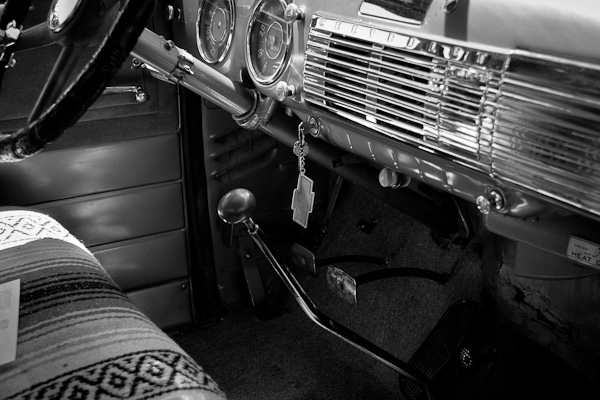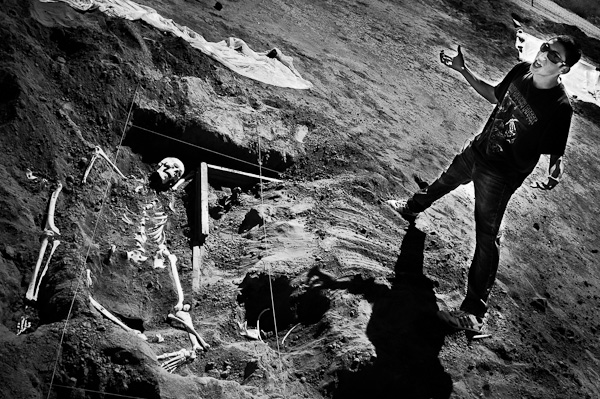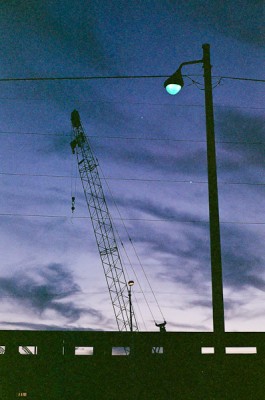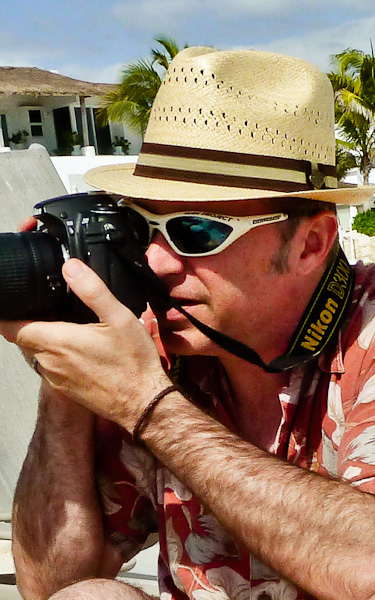I finally pulled the trigger yesterday. I finished a project I had been working on, both mentally and in actuality (although sometimes those two feel very much the same) and created a photobook. My intention with this photobook was to celebrate the colors that stared me in the face each time I visited the Yucatán Peninsula. A preview is available below as the book is available for purchase through the publisher, blurb.com. Just click the “buy” button to be taken to my blurb.com store.
Classic Car in HDR
Yesterday I posted a short series of images taken during a classic car show here in Albuquerque over last weekend. I had originally intended to include this image with them but I felt the contrast between this High Dynamic Range shot and the black and white ones to be too much. So I present it here instead. I just love the hat-holder!
Spinning my Wheels
My wife took pity on me. She’s noticed that I’ve been struggling with creativity for a little while now and she suggested we head down to the local classic car show here in Albuquerque. “The boys will love it, we’ll get out of the house for the afternoon, and you can take pictures!” she explained. Great!!
And it was! We had a fun time, my son ordered me around: “take a picture of THAT one, Daddy!!” I complied. Often.
I have to admit I did struggle a bit with the lighting conditions (high noon in the high desert is not a time I find optimal for photography-can anyone say “sunny 16 rule”?) but now that I’ve worked through a few images I’m finding myself quite happy. So here are a few from the afternoon. I’ve made them black and white-partially because I’m trying to learn more about this medium, and partially because I thought the images presented themselves better this way. I’ve also made one HDR that I’m enjoying quite a bit. I am waiting until tomorrow to post it because I didn’t feel like it flowed with these images, so check back again.
Working Through the Morass in the Creative Process
It has been a slow time in blog-land for me these past two weeks. A quick peek at my last post might give some idea why. Hanging out in the morass of Resistance is never an easy challenge and this bout is sure reminding me of that. But I have not sat still.
Thankfully I know that the morass of Resistance can be the fire out of which new creativity arises. The mythological symbol of the Phoenix rising from the ashes is an apt metaphor for this. So too is the Hindu Goddess Kali-the Goddess of Destruction. Before each new creation something else must give way. Psychologists, as well as others in the mental health fields, sometimes refer to this as Alchemical Transformation. While historically alchemists attempted to turn base metals into gold through purification methods and fire, this term can also metaphorically refer to the process of psychological growth; in the fire of our difficult emotions our psychological makeup can be transformed.
To me, creativity, aliveness, has some of its roots in our individual and collective psychology. So I see my own descent into the morass of Resistance, the fires of uncertainty and self doubt, as an opportunity for psychological and creative growth. A, perhaps small, rebirth.
So, following Steven Pressfield’s direction in “Do the Work” (read this postfor a more in dept look at this big little book) I have continued to do the work I can do. Lately I’ve taken to carrying my new-to-me Pentax K1000 film camera around and have learned about the vagaries of expired film; I’ve switched to shooting black and white on my digital cameras (I shoot RAW so the file is still ultimately in color, but the preview is B&W and that is helping me “see” in B&W”); and I have been working on a photobook with images from my trips to the Yucatán Penninsula in Mexico which will soon be available through blurb.com.
The outcome of all this work still remains to be seen. But I suppose it is fundamental to have some faith in the process; to know in one’s heart that all will be fine again, that the mojo will return and the creative sparks will ignite some fires.
Speaking of that, I’ve got this idea for a project….
The Morass of Resistance
The other day I wrote about an author, Steven Pressfield, and particularly two books of his that address a particular challenge that arises in most, if not all, creative people: Resistance. Then I smashed face-first into my own.
Pressfield describes Resistance as a naturally occurring force that comes, part and parcel, along with the urge to create; two sides of the same coin. This simple explanation has helped me tremendously. Mostly it helps with separating Resistance from who I am personally; it helps me to remove it from my egoic identification with myself. As a result it decreases the amount of shame I encounter when running into Resistance (i.e., writer’s block, loss of mojo, self doubt, self pity, procrastination, embarrassment, etc.). Since these are no longer reflective of who I am, they are no longer “my” faults, but rather they are part and parcel of creation. They are part of creation, and creativity, itself.
Part of the trick in working with Resistance and overcoming it is to identify when it happens. In his new book, Do The Work, Pressfield mentions that every project of significant effort will crash. There is a moment, perhaps short and perhaps not, that will leave you feeling like you can’t do it, it’s not good enough, it’s not worth enough, you are not worthy, good enough, smart enough, fast enough, bright enough, charming enough, deserving enough, …you get the point. Something, or everything, will conspire against you to make you give up, stop, quit, throw in the towel, fail. It might be that your hard drive crashes, the camera aperture mechanism quits, someone doesn’t like your work, YOU don’t like your work, you run out of money, you come into a large sum of money, whatever…
The key is that something will throw you off your game and it is up to you to notice it is Resistance, find the fix to the disruption, and finish the project. I had this happen to me recently.
As you might have noticed, this blog is my attempt to understand creativity through the photographic medium. It also involves writing, wondering, gnashing teeth, and wrestling with ideas. It also involves connecting with others. Well, as per usual, I did that the other day, happily proud of my observations and completely unaware that I would be bulldozed by Resistance. I wrote a comment on a contact’s blog about those hard-to-define buzzwords in photography: vision and voice. I was proud of what I wrote and wholly unprepared for what followed.
A couple of comments later was a comment from the mentor of the blog owner that I felt undercut my comment. I was crushed and felt myself buckle at the sting; and I experienced Resistance wash over me and begin to drag me down into its morass. Now, I have to point out that, upon reflection and re-reading, the comment by this person was not bad and not necessarily pointed at me. And, to be fair, probably was not even aimed at my fragile ego. The gentleman was simply making a point and taking part in the conversation. What is poignant in this experience for me was my interpretation of the commentary and what that did.
I began to doubt myself, slowly at first but then it began to gain steam: was I wrong?; did I know what I was talking about?; what right to I have to make a comment such as this?; do I even know what I am talking about?; this guy is a well respected photographer and I’m a nobody so I need to just shut up, or better yet, give up. stop. Quit while I’m ahead. Quit while I still can. With each negative thought my mind found evidence to validate it. I could feel myself begin to question my entire reason for blogging, for writing, for photographing even (after all I work a full-time plus job, I have a family to care for, a home to care for, aging parents to worry over…see, lots of validation for my questioning.) Woah, that was fast!
Thankfully I was simultaneously reading Do The Work, especially the section on your project crashing, and I was able, slowly, to notice that Resistance had me in a headlock. This knowledge can be enough to break free-and give fodder for a blog post or two about creativity. The trick is to notice that Resistance has arisen, identify any problem that is getting in the way of the work, fix it, and continue the work. For me that involved identifying and understanding my motivation for continuing this exploration of creativity through photography: to answer the “why” of the quest; to find the meaning in the journey. By knowing this I can settle back into to work despite Resistance gnashing at my ankles. And perhaps I can continue to try to define my understanding of vision and voice.
Inspiration Monday: Author Steven Pressfield
This is an umpteenth post in my series of people, places, things that inspires me to continue on this lively, rewarding, and often frustrating journey of creativity. Today I stear away from my usual photographic inclinations into one of my side inclinations: writing. Steven Pressfield is an author (most noted for The Legend of Bagger Vance among others) who has written two little books recently that I consider “must reads” for anyone living the creative life, wanting to live the creative life, or trying to live life creatively.
While he most often writes about war and warriors, Pressfield feels to me like a deeply spiritual, deeply connected individual who uses the warrior’s ethos in much the same way spiritual teachers such as Dan Millman (author of “The Peaceful Warrior“) do. He sees war as a metaphor for the internal struggles our individual psyches face and as such wrote The War of Art and, more recently, Do the Work as manifestos, directives, orders to we creatives to wrestle Resistance (his term for that force within each of us that thwarts creativity and its expression) to the ground, pin it there, and keep it subdued while we do the work of creating.
Let me tell you, for me reading 5 pages of either of Pressfield’s two manifestos and I am ready to tackle the largest possible projects that come to mind. Staying true to his ethos he defines Resistance, analyzes its methods and capabilities, and plans and executes a strategy for overcoming it. Written in a clear, direct, pull-no-punches style The War of Art and Do the Work offer an enormous service to those of us with fantastic ideas and a knack for being thwarted in our execution of them.
While The War of Art details Resistance and a method deal with it, Do the Work takes things one step farther and lays out the gameplan for how to begin and complete a project while simultaneously managing the wriggling demon of Resistance. I highly recommend reading and re-reading these two books to anyone who has more vision that voice, more getup than go, whose ability to begin new projects is more refined than their ability to complete them.
It is fortuitous that I was reading Do The Work this past week as one of the major manifestations of Resistance unleashed itself within me. Thankfully I had Pressfield’s book in hand to help identify it for what it was and guide me through the mental-emotional morass I found myself in. I will be writing an account of it in my next blog post; I am still working my way through the morass and have yet to find the right words to depict what I’ve been struggling with, but they are coming. So please bear with me as I put words to this confusing experience. It has been challenging, but so educational and timely!
6 Things My Magic Camera Knows About Taking Better Pictures
It has happened often enough for me to notice a pattern: I am taking pictures of a friend or family member, or of their kids, and I show them what I just captured on the LCD screen on the back of the camera. “Oooh, that’s a great shot; what a nice camera!” or “Wow, it pays to have a good camera,” or “Wow, I need to get a magic camera too.”
I am learning, slowly, to accept these statements as compliments to me despite being directed at my camera, but it is hard sometimes. I am not the first photographer this has happened to. For some reason lay-photographers believe the quality of an image comes from the tool used to produce it, as if Rembrandt or van Gogh had magic paintbrushes. I suppose since most everyone can push a shutter release button and thereby take a picture photography loses some respect as an artistic medium, and that makes me sad. I know people don’t mean to insult my art when they say such things, but it happens.
Yes most people can take a picture, and even a pretty picture. Most people can grow up and learn to cook too, but that doesn’t make them a chef. And I certainly would not give my good friend Chef Drew’s pots and pans credit for the delectable creations he dreams up and places on the table. There is so much that goes into creating a memorable photograph, on purpose, with intention, and the camera helps the photographer create their vision. But the camera is secondary to the image. And the image is not necessarily dependent on the quality of the camera. In fact, some photographers prefer cheap plastic cameras for the aesthetics they help create.
So what is it that good photographers, or perhaps their magic cameras, know that help them create beautiful images? Well, that can take a lifetime for individual photographers to discover but listed below are some things I have learned in my time as a photographer and I think they might help you as well.
- Change your point of view (POV): we all stand basically about the same heightand as a result most images are taken from about 5 feet off the ground, so most images tell us a story from the same perspective. Change it up, get low, get high, tilt your camera at a creative angle. This is especially true when taking pictures of your kids or grandkids. I know some folks where every picture of their children has the poor kiddo looking up, neck craned all the way back, with a grimace of pain and discomfort on their face. Get low, shoot them from their pointof view. You will get a more unique image of them in their natural state, and possibly even a smile.
- Learn a little about how your camera measures the amount of light in a scene. Most of us buy a camera, pull it out of the box, charge the battery, and start snapping away; I know I did. Nowadays I am aware of how the camera actually “sees” the image and, unfortunately or fortunately, it cannot see it the way our eyes do. It just can’t. Our eyes can see details in shadows and in highlights at the same time: they have a “high dynamic range.” The camera cannot. And so, we photographers have to choose where we want the detail: in the shadows or in the highlights? While some might consider this a limitation of camera technology, this inability to correctly render the same scene we are viewing, the photographer uses the restriction to render a representation of what is viewed. Art is the byproduct of such a decision.
- Look to the light! Photographs are all about light! You, with your camera, are capturing light that has quite literally bounced off your subject and through your lens onto your film or sensor. Light is critically important in photography and photographers study it, intensely. I’m sure you know that light has different qualities, right? There is the warm yellow light of sunset, followed by the deep blue light after sunset. There’s hard intense light in the bright midday, and soft light of an overcast day. None of these is better or worse than the other, they will just create different moods and photographers use the light to create the moods they want. What mood do you want?
- Learn a little about aesthetics of making photographic images. Intentional blur or limited depth of field (basically determining what is intentionally in, and out, of focus) go a long way toward creating mood in an image and, interestingly, this is generally what moves us about an image: the mood. Images are a visual language and, although we can explain why an image is interesting to us, we are generally moved emotionally by an image first. Photographers tend to pay attention to the emotions and moods they are invoking. By the way, intentionally slow shutter speeds create blurs, and large apertures (small f-stop numbers) create shallow depths of fields with more out of focus regions in the frame.
- Practice! I realize you may not have an interest in becoming an entrenched hobbyist photographer, but if your goal is to take some good images of your family (read: kids! pets!) and the wonderful vacations you take, you have chosen some of the most difficult subject matter to photograph. I know. I have two little ones and I am repeatedly surprised by how rapid they are, as well as how impatient, impulsive, and occasionally obstinate. Getting them to understand how important their cooperation is to creating that yearly calendar or Holiday card is no easy feat. I stand a much better chance of snagging a few good images if I have practiced and practiced and practiced.
- Read up! There are many wonderful books available to learn more about photography but some of the best are the most simple. I learned the most from a series of ebooks created by World and Humanitarian Photographer, best selling author, and teacher David duChemin over at Craft and Vision. I particularly found “Ten”, “Ten More”, and “Drawing The Eye” extremely useful.
There, phew(!), that was a long one. I hope you’ve enjoyed my humble suggestions as well my encouragement to join me in capturing more of this beautiful world on film or in bits and bytes. I’ve come to love photography over the past few years and I hope you do to. In the meantime, while you and I both practice, I will also try to come to terms with my magic camera receiving all the credit.
eBooks to Change Your Life
 That is a bold statement above, I know it is. But really, if you are as passionate about the visual language of photography (as I am) and you really came into your photographic mojo with the advent of digital Single Lens Reflex (dSLR) cameras (meaning in the last 5-7 years, like I did) and therefore tend to shoot in color and allow the camera to pre-visualize the scene for you through the instant gratification (LCD) screen on the back with full hyper-saturated glory, it just might. Black and White photography is a dark and dreamy world for many photographers, a land of light and shadows where some things are revealed and some concealed, an extra step removed from reality creating an air of mystery and fascination, and while many of us just love black and white images we lack the ability to really understand how to make a compelling image this way.
That is a bold statement above, I know it is. But really, if you are as passionate about the visual language of photography (as I am) and you really came into your photographic mojo with the advent of digital Single Lens Reflex (dSLR) cameras (meaning in the last 5-7 years, like I did) and therefore tend to shoot in color and allow the camera to pre-visualize the scene for you through the instant gratification (LCD) screen on the back with full hyper-saturated glory, it just might. Black and White photography is a dark and dreamy world for many photographers, a land of light and shadows where some things are revealed and some concealed, an extra step removed from reality creating an air of mystery and fascination, and while many of us just love black and white images we lack the ability to really understand how to make a compelling image this way.
Thankfully those that inhabit this world photographically are not so dark and mysterious as the medium and some have chosen to share their knowledge through several ebooks on the Craft and Vision website. At just $5 a pop they are probably the least expensive investment into your photographic journey and given the impact they can achieve on your photography I think they can change your (photographic) life quite dramatically for very little.
First off is Andrew Gibson’s “The Magic of Black and White” series (Parts I, II, and III) published through Craft and Vision where he guides the reader through the different thought processes required in making black and white images. I found that thinking about an image in terms of tones of grey, in terms of contrast, to be so beneficial that it has improved my photography overall, including my color photography.
The one drawback of Gibson’s books for me, if there really is one, is that he prefers to work in Photoshop and therefore his conversion techniques require extra work for Lightroom users such as me. Well, no longer. Craft and Vision this week announced the release of their first mega-ebook.
 Weighing in at a hefty 100 pages “The Power of Black and White In Adobe Lightroom & Beyond: A Masterclass” by Piet Van den Eynde is everything the Lightroom enthusiast of black and white photography has been waiting for. This is by far the largest ebook produced by the good folks at Craft and Vision and for only $5 (or $4 if you use discount code BWLIGHT4 before April 16 2010) it is an outrageous deal. Imagine, at 100 2-page spreads this would easily be a 200 page print book! And the workflow described in detail by Van den Eynde is easily reproduced in Adobe Camera Raw.
Weighing in at a hefty 100 pages “The Power of Black and White In Adobe Lightroom & Beyond: A Masterclass” by Piet Van den Eynde is everything the Lightroom enthusiast of black and white photography has been waiting for. This is by far the largest ebook produced by the good folks at Craft and Vision and for only $5 (or $4 if you use discount code BWLIGHT4 before April 16 2010) it is an outrageous deal. Imagine, at 100 2-page spreads this would easily be a 200 page print book! And the workflow described in detail by Van den Eynde is easily reproduced in Adobe Camera Raw.
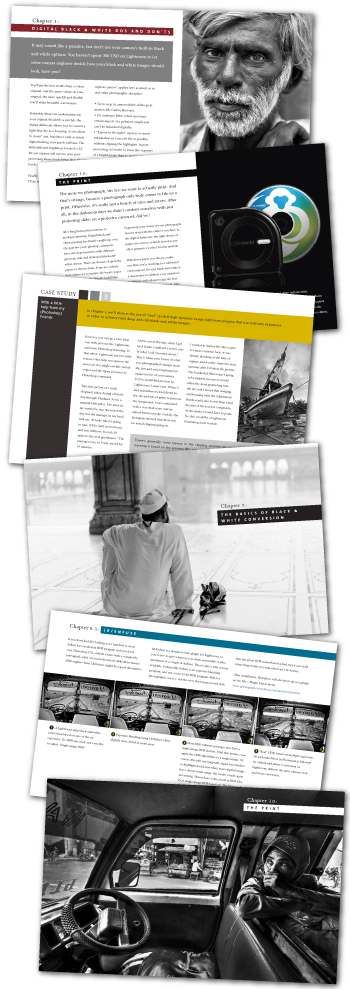 While I have glanced through The Power of Black and White in Adobe Lightroom & Beyond: A Masterclass I cannot wait to really spend some time with this book. This is the kind of book that deserves some concentrated attention, study, and continued referencing to really mine the content. And in doing so, this might really alter your photography positively and, as a result, change your life.
While I have glanced through The Power of Black and White in Adobe Lightroom & Beyond: A Masterclass I cannot wait to really spend some time with this book. This is the kind of book that deserves some concentrated attention, study, and continued referencing to really mine the content. And in doing so, this might really alter your photography positively and, as a result, change your life.
But wait! There’s more! Because Piet spends a little time talking about the power of plug-ins like NiK Software’s Silver Efex pro, NiK has ponied up 3 full versions of Silver Efex Pro, which anyone that buys this masterclass is eligible to win if you buy the book within the first 5 days, which also happens to be the time frame during which you can get the book for $4, or buy 5 ebooks for the price of 4.
Special PDF Offer
For the first five days only, if you use the promotional code BWLIGHT4 when you checkout, you can have the PDF version of The Power of Black & White in Adobe Lightroom & Beyond (A MASTERCLASS) for only $4 OR use the code BWLIGHT20 to get 20% off when you buy 5 or more PDF ebooks from the Craft & Vision collection. These codes expire at 11:59pm PST April 16, 2011.
Inspiration Monday: Sabrina Henry; the lady who chronicles learning photography
 Mondays are a fun time for me. Mondays are a transition time where I leave the responsibilities of home (husband, father, caregiver) and move back into my day job and all that entails. It is also a time when I get to share what is inspiring me, what is motivating me, what is keeping the spark of life and creativity alive in me despite the pressure of providing, caregiving, husbanding, and fathering. Today that inspiration is twofold: one is the motivating quality of those people in general that know how to take action on their goals and; the second is one such person, Sabrina Henry, who does just that, especially today.
Mondays are a fun time for me. Mondays are a transition time where I leave the responsibilities of home (husband, father, caregiver) and move back into my day job and all that entails. It is also a time when I get to share what is inspiring me, what is motivating me, what is keeping the spark of life and creativity alive in me despite the pressure of providing, caregiving, husbanding, and fathering. Today that inspiration is twofold: one is the motivating quality of those people in general that know how to take action on their goals and; the second is one such person, Sabrina Henry, who does just that, especially today.
Sabrina is a photographer from Canada who has build a following on the net recently not so much through her photography (although it is quite good), but through her Chronicles of Learning Photography. In addition, she has an incredible ability to connect with others through social media and has become the voice of Craft and Vision, David duChemin’s ebook publishing company, as a result. It has been fun to follow her chronicles and watch as she immerses herself in her photographic education.
However, what really inspired me today was her announcement of the birthing of her latest project. Entitled “Rear Curtain“, her collaborative website dedicated to visual storytelling and supporting other visual storytellers, went live today and I find it just wonderful. This website is an example of Sabrina’s ability to get things accomplished. She appears to stay open to ideas and opportunity, from both herself and others, and then follows through with them. This was a timely announcement as I had just been pondering the nature of motivation with a client and had researched Stephen Pressfield’s forthcoming book “Do the Work” as well as Seth Godin’s “Poke the Box” that deal with the action phase of a project. Imagine my joy when I switched from Amazon.com to Facebook and noticed Sabrina’s post about “Rear Curtain”.
So, not only does she motivate and inspire me through her example to begin and follow through on projects, she is also motivating me to get something together for a submission to “Rear Curtain”. Stay tuned! 🙂
Travel Heavy, travel light
 I can’t decide. Sometimes I resign myself to lugging all sorts of camera gear around: umbrellas, reflectors, tripods, lenses, camera bodies…all sorts of goodies. Other times I think that life is just made so much more complicated by so many choices and “needs” and I just want to simple things down. At times like these I wish I owned a Leica M9 or, more realistically, a Nikon P7000, or Canon G11, or Fuji X100; simple, streamlined, but high quality cameras.
I can’t decide. Sometimes I resign myself to lugging all sorts of camera gear around: umbrellas, reflectors, tripods, lenses, camera bodies…all sorts of goodies. Other times I think that life is just made so much more complicated by so many choices and “needs” and I just want to simple things down. At times like these I wish I owned a Leica M9 or, more realistically, a Nikon P7000, or Canon G11, or Fuji X100; simple, streamlined, but high quality cameras.
 So I’ve taken to trying different approaches. Last fall I shot the Muertos y Marigolds Day of the Dead parade here with a bag full of gear and two cameras-one with a zoom to get in on all the action, one with a wide angle in order to capture some cool images of the low-rider cars rolling through. This weekend, while running around town with my wife and two young children, I grabbed my small Crumpler bag containing my Nikon D80 and a 50mm f1.8 lens. One simple(r) camera body and one simple, non-zoom, lens.
So I’ve taken to trying different approaches. Last fall I shot the Muertos y Marigolds Day of the Dead parade here with a bag full of gear and two cameras-one with a zoom to get in on all the action, one with a wide angle in order to capture some cool images of the low-rider cars rolling through. This weekend, while running around town with my wife and two young children, I grabbed my small Crumpler bag containing my Nikon D80 and a 50mm f1.8 lens. One simple(r) camera body and one simple, non-zoom, lens.
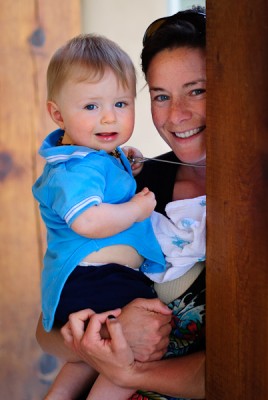 Boy, the feeling of freedom that came with the simple setup was grand. Did I wish for other lenses or my D300? Sure. A time or two. But without having them I was able to move through the “shucks” faze and work with what I had: some yummy light, 3 subjects I just adore, a nice backdrop. And, as a serious bonus, since I was less focused on my gear I actually got to connect more with my wife and kids. The camera didn’t stand between me and them, but rather sort of disappeared as it became part of what we were all doing. And so now the images I created are visual reminders of a day well spent, rather than the focus of the day.
Boy, the feeling of freedom that came with the simple setup was grand. Did I wish for other lenses or my D300? Sure. A time or two. But without having them I was able to move through the “shucks” faze and work with what I had: some yummy light, 3 subjects I just adore, a nice backdrop. And, as a serious bonus, since I was less focused on my gear I actually got to connect more with my wife and kids. The camera didn’t stand between me and them, but rather sort of disappeared as it became part of what we were all doing. And so now the images I created are visual reminders of a day well spent, rather than the focus of the day.
I wonder, could we manage to connect better with our subjects and have a more rewarding experience with them if we just chose to travel light at times? What would it be like to travel with my D80-50mm lens setup, say to Paris? Or to Thailand? Perhaps I would be limited, but would that limitation actually force me to see differently, to look more for scenes, subjects, backgrounds, light–yummy gorgeous light?





